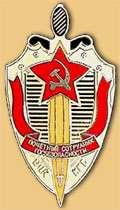 The
basic organizational structure of the KGB (Organization of the
Committee for State Security) was created in 1954, when the
reorganization of the police apparatus was carried out. In the
late 1980s, the KGB remained a highly centralized institution,
with controls implemented by the Politburo through the KGB headquarters
in Moscow. The
basic organizational structure of the KGB (Organization of the
Committee for State Security) was created in 1954, when the
reorganization of the police apparatus was carried out. In the
late 1980s, the KGB remained a highly centralized institution,
with controls implemented by the Politburo through the KGB headquarters
in Moscow.
During Soviet times, the secret police, under its various
designations, earned a notorious reputation as the eyes and
ears - and often executioner - for the state.
The KGB had a broad network of special departments in
all major government institutions, enterprises, and factories.
They generally consisted of one or more KGB representatives,
whose purpose was to ensure the observance of security regulations
and to monitor political sentiments among employees. The special
departments recruited informers to help them in their tasks.
A separate and very extensive network of special departments
existed within the armed forces and defense-related institutions.
|
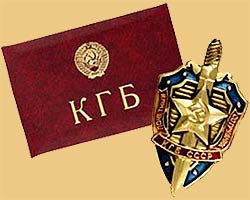 Although
a union-republic agency, the KGB was highly centralized and
was controlled rigidly from the top. The KGB central staff kept
a close watch over the operations of its branches, leaving the
latter minimal autonomous authority over policy or cadre selection.
Moreover, local government organs had little involvement in
local KGB activities. Indeed, the high degree of centralization
in the KGB was reflected in the fact that regional KGB branches
were not subordinated to the local soviets, but only to the
KGB hierarchy. Thus, they differed from local branches of most
union-republic ministerial agencies, such as the MVD, which
were subject to dual subordination. Although
a union-republic agency, the KGB was highly centralized and
was controlled rigidly from the top. The KGB central staff kept
a close watch over the operations of its branches, leaving the
latter minimal autonomous authority over policy or cadre selection.
Moreover, local government organs had little involvement in
local KGB activities. Indeed, the high degree of centralization
in the KGB was reflected in the fact that regional KGB branches
were not subordinated to the local soviets, but only to the
KGB hierarchy. Thus, they differed from local branches of most
union-republic ministerial agencies, such as the MVD, which
were subject to dual subordination.
|
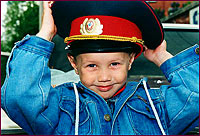 Party
personnel policy toward the KGB was designed not only to ensure
that the overall security needs of the state were met by means
of an efficient and well-functioning political police organization
but also to prevent the police from becoming too powerful and
threatening the party leadership. Party
personnel policy toward the KGB was designed not only to ensure
that the overall security needs of the state were met by means
of an efficient and well-functioning political police organization
but also to prevent the police from becoming too powerful and
threatening the party leadership.
|
 Achieving
these two goals required the careful recruitment and promotion
of KGB officials who had the appropriate education, experience,
and qualifications as determined by the party. Judging from
the limited biographical information on KGB employees, the Komsomol
and the party were the main sources of recruitment to the KGB.
Russians and Ukrainians predominated in the KGB; other nationalities
were only minimally represented. In the non-Russian republics,
KGB chairmen were often representatives of the indigenous nationality,
as were other KGB employees. In such areas, however, KGB headquarters
in Moscow appointed Russians to the post of first deputy chairman,
and they monitored activities and reported back to Moscow. Achieving
these two goals required the careful recruitment and promotion
of KGB officials who had the appropriate education, experience,
and qualifications as determined by the party. Judging from
the limited biographical information on KGB employees, the Komsomol
and the party were the main sources of recruitment to the KGB.
Russians and Ukrainians predominated in the KGB; other nationalities
were only minimally represented. In the non-Russian republics,
KGB chairmen were often representatives of the indigenous nationality,
as were other KGB employees. In such areas, however, KGB headquarters
in Moscow appointed Russians to the post of first deputy chairman,
and they monitored activities and reported back to Moscow.
The KGB had a variety of domestic security functions.
It was empowered by law to arrest and investigate individuals
for certain types of political and economic crimes. It was also
responsible for censorship, propaganda, and the protection of
state and military secrets.
|
|
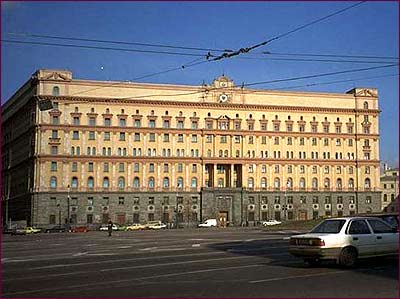
Headquarters of the KGB, Lubyanka,
Moscow.
In carrying out its task of ensuring state security,
the KGB was empowered by law to uncover and investigate certain
political crimes set forth in the Russian Republic's Code of
Criminal Procedure and the criminal codes of other republics.
According to the Russian Republic's Code of Criminal Procedure,
which came into force in 1960 and has been revised several times
since then, the KGB had the authority, together with the Procuracy,
to investigate the political crimes of treason, espionage, terrorism,
sabotage, anti-Soviet agitation and propaganda, divulgence of
state secrets, smuggling, illegal exit abroad, and illegal entry
into the Soviet Union. In addition, the KGB was empowered, along
with the Procuracy and the MVD, to investigate the following
economic crimes: stealing of state property by appropriation
or embezzlement or by abuse of official position and stealing
of state property or socialist property on an especially large
scale.

|
|

Moscow, guard on the Red Square. |

|
|
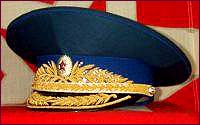 In
carrying out arrests and investigations for these crimes,
the KGB was subject to specific rules that were set forth
in the Code of Criminal Procedure. The Procuracy was charged
with ensuring that these rules were observed. In practice,
the Procuracy had little authority over the KGB, and the latter
was permitted to circumvent the regulations whenever politically
expedient. In 1988 closing some of these loopholes was discussed,
and legal experts called for a greater role for the Procuracy
in protecting Soviet citizens from abuse by the investigatory
organs. As of May 1989, however, few concrete changes had
been publicized. In
carrying out arrests and investigations for these crimes,
the KGB was subject to specific rules that were set forth
in the Code of Criminal Procedure. The Procuracy was charged
with ensuring that these rules were observed. In practice,
the Procuracy had little authority over the KGB, and the latter
was permitted to circumvent the regulations whenever politically
expedient. In 1988 closing some of these loopholes was discussed,
and legal experts called for a greater role for the Procuracy
in protecting Soviet citizens from abuse by the investigatory
organs. As of May 1989, however, few concrete changes had
been publicized.
 The
intensity of KGB campaigns against political crime varied
considerably over the years. The Khrushchev period was marked
by relative tolerance toward dissent, whereas Brezhnev reinstituted
a harsh policy. The level of political arrests rose markedly
from 1965 to 1973. In 1972 Brezhnev began to pursue détente,
and the regime apparently tried to appease Western critics
by moderating KGB operations against dissent. There was a
sharp reversal after the Soviet invasion of Afghanistan in
December 1979, and arrests again became more numerous. In
1986, Gorbachev's second year in power, restraint was reintroduced,
and the KGB curtailed its arrests. The
intensity of KGB campaigns against political crime varied
considerably over the years. The Khrushchev period was marked
by relative tolerance toward dissent, whereas Brezhnev reinstituted
a harsh policy. The level of political arrests rose markedly
from 1965 to 1973. In 1972 Brezhnev began to pursue détente,
and the regime apparently tried to appease Western critics
by moderating KGB operations against dissent. There was a
sharp reversal after the Soviet invasion of Afghanistan in
December 1979, and arrests again became more numerous. In
1986, Gorbachev's second year in power, restraint was reintroduced,
and the KGB curtailed its arrests.
The forcible confinement of dissidents in psychiatric
hospitals, where debilitating drugs were administered, was
an alternative to straightforward arrests. This procedure
avoided the unfavorable publicity that often arose with criminal
trials of dissenters. Also, by labeling dissenters madmen,
authorities hoped to discredit their actions and deprive them
of support. The KGB often arranged for such commitments and
maintained an active presence in psychiatric hospitals, despite
the fact that these institutions were not under its formal
authority. The Gorbachev leadership, as part of its general
program of reform, introduced some reforms that were designed
to prevent the abuse of psychiatric commitment by Soviet authorities,
but the practical effects of these changes remained unclear
in 1989.
In addition to arrests, psychiatric commitment, and other
forms of coercion, the KGB also exercised a preventive function,
designed to prevent political crimes and suppress deviant political
attitudes. The KGB carried out this function in a variety of
ways. For example, when the KGB learned that a Soviet citizen
was having contact with foreigners or speaking in a negative
fashion about the Soviet regime, it made efforts to set him
or her straight by means of a "chat."
The KGB also devoted great efforts to political indoctrination
and propaganda. At local and regional levels, KGB officials
regularly visited factories, schools, collective farms, and
Komsomol organizations to deliver talks on political vigilance.
National and republic-level KGB officials wrote articles and
gave speeches on this theme. Their main message was that the
Soviet Union was threatened by the large-scale efforts of Western
intelligence agencies to penetrate the country by using cultural,
scientific, and tourist exchanges to send in spies. |
|
|



